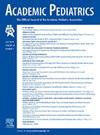Suicide-Risk Identification Across Developmental and Behavioral Pediatric Practices: A DBPNet Study
IF 2.8
3区 医学
Q1 PEDIATRICS
引用次数: 0
Abstract
Objective
To identify variations in practices, facilitators of and barriers to universal suicide screening of children and adolescents with IDDs in pediatric developmental and behavioral health settings.
Methods
Centers from the Developmental Behavioral Pediatrics Research Network (DBPNet) were invited to describe suicide-screening practices in their developmental-behavioral pediatrics, psychology, and/or psychiatry clinics. A representative per site/specialty was asked to complete surveys (summarized with descriptive statistics) and semi-structured interviews (summarized using thematic analysis) to explore sites’ current practices, and barriers/facilitators to screening.
Results
Participants included 34 survey respondents and 21 interviewees. Surveys revealed variation in suicide screening practices across sites; 44.1% of respondents reported that their practice conducts universal screening, but the screening processes varied widely. Interviews identified some facilitators to screening youth with IDD, such as standardizing procedures, training, and having staff available to respond to positive screens. Barriers to universal screening include factors at the patient, family, provider, and system levels. Insufficient mental health care systems, as well as a lack of IDD-specific supports, are significant challenges.
Conclusions
Despite Joint Commission requirements and specific expertise in behavioral health, sites serving patients with IDD vary widely in how suicide screening is implemented and how positive screens are addressed. Findings offer opportunities to standardize procedures to increase suicide risk identification and response.
跨发育和行为儿科实践的自杀风险识别:一项DBPNet研究。
背景:自闭症和其他智力/发育障碍(IDD)个体自杀风险的识别越来越需要发展行为儿科(DBP)、心理学和精神病学实践,这些实践经常为这些人群服务。需要提高对当前风险识别实践的理解。目的:确定在儿童发育和行为健康机构中,对患有缺碘症的儿童和青少年进行普遍自杀筛查的做法、促进因素和障碍的差异。方法:邀请来自发展行为儿科研究网络(DBPNet)的中心描述其发展行为儿科、心理学和/或精神病学诊所的自杀筛查实践。每个站点/专业的代表被要求完成调查(用描述性统计总结)和半结构化访谈(用专题分析总结),以探索站点当前的做法,以及筛选的障碍/促进因素。结果:调查对象34人,受访者21人。调查显示,不同地点的自杀筛查做法存在差异;44.1%的答复者报告说,他们的做法进行普遍筛查,但筛查过程差别很大。访谈确定了筛查青少年缺乏症的一些促进因素,如使程序标准化、培训和让工作人员对阳性筛查做出反应。普遍筛查的障碍包括患者、家庭、提供者和系统层面的因素。精神卫生保健系统不足以及缺乏针对缺碘症的支持是重大挑战。结论:尽管有联合委员会的要求和行为健康方面的专门知识,但为IDD患者服务的地点在如何实施自杀筛查和如何处理阳性筛查方面差异很大。研究结果为提高自杀风险识别和应对的标准化程序提供了机会。
本文章由计算机程序翻译,如有差异,请以英文原文为准。
求助全文
约1分钟内获得全文
求助全文
来源期刊

Academic Pediatrics
PEDIATRICS-
CiteScore
4.60
自引率
12.90%
发文量
300
审稿时长
60 days
期刊介绍:
Academic Pediatrics, the official journal of the Academic Pediatric Association, is a peer-reviewed publication whose purpose is to strengthen the research and educational base of academic general pediatrics. The journal provides leadership in pediatric education, research, patient care and advocacy. Content areas include pediatric education, emergency medicine, injury, abuse, behavioral pediatrics, holistic medicine, child health services and health policy,and the environment. The journal provides an active forum for the presentation of pediatric educational research in diverse settings, involving medical students, residents, fellows, and practicing professionals. The journal also emphasizes important research relating to the quality of child health care, health care policy, and the organization of child health services. It also includes systematic reviews of primary care interventions and important methodologic papers to aid research in child health and education.
 求助内容:
求助内容: 应助结果提醒方式:
应助结果提醒方式:


